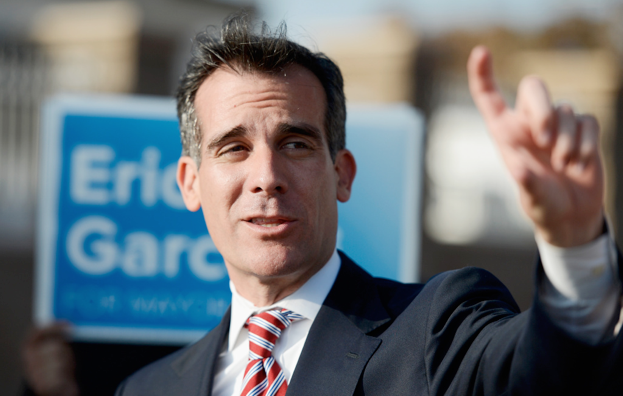His Honor and the Grasshoppers Raid LA’s Rainy Day Funds
LA WATCHDOG--While the City’s General Fund revenues have increased by $1.24 billion (27%) over the last five years, why is the cash balance of City’s Reserve Fund projected to be $21 million below the policy goal of $289 million, an amount equal to 5% of General Fund revenue of $5.8 billion?
But more to the point, why are the combined balances of the Reserve Fund and the Budget Stabilization Fund $215 million short of the $578 million policy goal (equal to 10% of General Fund revenue) recommended by the City Administrative Officer?
Over the years, the CAO has been a broken record, stressing that the City maintain healthy and growing reserves because they are an important component supporting the City’s high investment grade bond ratings. This is especially true given the City’s Structural Deficit (where the growth in personnel costs exceed the increases in revenues), the City’s massive unfunded pension and deferred maintenance liabilities, and the volatility of the Southern California economy.
Underlying this deficit in the City’s reserves is the fact that City Hall has raided the Reserve Fund for $213 million over the last three years. This is despite healthy increases in revenues. As a result, the cash balance is projected to be $268 million on June 30, 2018, only 4.6% of General Fund revenue, the lowest level in years.
But this estimate may be on the high side because the Reserve Fund may have to cover budget shortfalls for this fiscal year caused by lower than expected revenues and higher than anticipated legal settlements. There may also be budget shortfalls for the upcoming fiscal year because of continuing legal liabilities that may exceed the projected budget of only $109 million.
City Hall was unable to divert funds from the Reserve Fund for the upcoming fiscal year because the cupboard was bare. But that did not stop the financial wizards from diverting $75 million from the $95 million Budget Stabilization Fund.
The City has funded the Budget Stabilization Fund with excess revenues from seven economy sensitive taxes: Property Taxes, Utilities Users’ Tax, Business Tax, Sales Tax, Transit Occupancy Tax, Documentary Transfer Tax, and Parking Users’ Tax. Revenues are considered excess when they are more than 3.4% above the prior year’s budgeted revenues.
But rather than devote the $75 million of excess revenues to the rainy day funds, City Hall allocated this cash to the Capital Improvement Expenditure Program, claiming these funds were devoted to one time capital expenditures. But the Capital Improvement Expenditure Program is an integral part of every annual budget, not a bunch of one off expenditures as City Hall would like us to believe.
In years of plenty, prudent stewards of our money would put excess cash into reserves so that we will have adequate resources when the lean years are upon us. But the grasshoppers who occupy City Hall have not learned this basic lesson of life and finance as they continue their spendoholic ways and ignore the realities of our volatile Southern California economy.
City Hall will more than likely issue $60 million of Judgment Obligation Bonds to help shore up the Reserve Fund. But this is only an interim, ill conceived, debt financed maneuver. The real question is whether Mayor Garcetti, Budget and Finance Chair Paul Krekorian, and the rest of the Herb Wesson led City Council have the political will to do the right thing and sock away enough cash so we can endure the down economy.
The odds say no way.
(Jack Humphreville writes LA Watchdog for CityWatch. He is the President of the DWP Advocacy Committee and is the Budget and DWP representative for the Greater Wilshire Neighborhood Council. He is a Neighborhood Council Budget Advocate. He can be reached at: [email protected].)
-cw




 Nor did the Board members discuss the services to be performed under this open-ended contract that did not have a specific work plan or a specific list of projects. But more to the point, they did not examine the capabilities of the Discovery Cube and its ability to deliver cost effective services to Sanitation, especially when compared to other advertising mediums or venues.
Nor did the Board members discuss the services to be performed under this open-ended contract that did not have a specific work plan or a specific list of projects. But more to the point, they did not examine the capabilities of the Discovery Cube and its ability to deliver cost effective services to Sanitation, especially when compared to other advertising mediums or venues. 



 All this makes for a very nice pension plan for IBEW Union Bo$$ d’Arcy, the Local 18’s long time business manager. But if you talk to his members, they are not complaining about his generous compensation or his rich retirement package. To the contrary, they believe he has earned every cent given what he has accomplished for his more than 8,000 members who enjoy above average wages and benefits.
All this makes for a very nice pension plan for IBEW Union Bo$$ d’Arcy, the Local 18’s long time business manager. But if you talk to his members, they are not complaining about his generous compensation or his rich retirement package. To the contrary, they believe he has earned every cent given what he has accomplished for his more than 8,000 members who enjoy above average wages and benefits. 




























